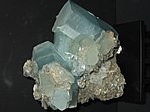
Back Heksagonale digpakking Afrikaans نظام بلوري سداسي Arabic Sistema hexagonal Catalan Šesterečná soustava Czech Hexagonales Kristallsystem German Heksagona kristalsistemo Esperanto Sistema cristalino hexagonal Spanish Heksagonaalne süngoonia Estonian Kristal-sistema hexagonal Basque دستگاه بلوری ششگوشه Persian
| Crystal system | Trigonal | Hexagonal | |
|---|---|---|---|
| Lattice system |  Rhombohedral |
 Hexagonal | |
| Example |  Dolomite (white) |
 α-Quartz |
 Beryl |
In crystallography, the hexagonal crystal family is one of the 6 crystal families, which includes two crystal systems (hexagonal and trigonal) and two lattice systems (hexagonal and rhombohedral). While commonly confused, the trigonal crystal system and the rhombohedral lattice system are not equivalent (see section crystal systems below).[1] In particular, there are crystals that have trigonal symmetry but belong to the hexagonal lattice (such as α-quartz).
The hexagonal crystal family consists of the 12 point groups such that at least one of their space groups has the hexagonal lattice as underlying lattice, and is the union of the hexagonal crystal system and the trigonal crystal system.[2] There are 52 space groups associated with it, which are exactly those whose Bravais lattice is either hexagonal or rhombohedral.
- ^ Hahn, Theo, ed. (2005). International tables for crystallography (5th ed.). Dordrecht, Netherlands: Published for the International Union of Crystallography by Springer. ISBN 978-0-7923-6590-7.
- ^ Dana, James Dwight; Hurlbut, Cornelius Searle (1959). Dana's Manual of Mineralogy (17th ed.). New York: Chapman Hall. pp. 78–89.
© MMXXIII Rich X Search. We shall prevail. All rights reserved. Rich X Search